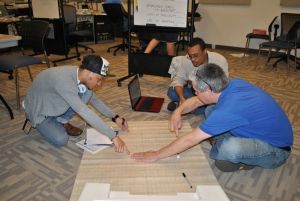
New York public school students are about to begin playing instructional games created by faculty and students at Hostos Community College for Game-Framed Mathematics and Science (G-FMS), a National Science Foundation Advanced Technological Education project. The games created to help Hostos' digital media students succeed in remedial and introductory math and science courses are now aiming for wider use among younger students.
G-FMS Principal Investigator Rees Shad said middle school and high school teachers in District 7, the region of the New York City Public Schools in the South Bronx, are beginning to incorporate the games in their classroom instruction. With the assistance of Hostos President David Gómez, Shad and his team will soon meet with top New York City School officials about using the games in fourth grade classrooms throughout the city.
As an open resource, the games are available for free download under the GAMES tab of G-FMS's website: http://commons.hostos.cuny.edu/gfms/games/
This summer the games will be part of the Hostos' 2Gen College for Kids Summer academic activities the college offers on campus for the children of it students. In 2014 and 2015 the games were used during a four-week Summer Games Institute for students from the city's Health, Education, and Research Occupations (H.E.R.O.) High School.
The games have also been the springboard for an entrepreneurial enterprise—Colmena Design LLC. It was formed by several Hostos alumni. As students, the alumni participated in the Hostos Hive Cooperative. As paid tech tutors they worked alongside Shad and Catherine Lewis, G-FMS co-principal investigator, and created more than a dozen instructional board games in the summer of 2013.
The for-profit game design company operates out of the Hostos Media Business Incubator (www.hostosmbi.com) near the College’s South Bronx campus. While the GFMS games are available for free from the project's website, the start-up's products include ready-made versions of the G-FMS games available at (www.thegamecrafter.com). These versions save teachers assembly time and the cost of printing.
"They are designing games like G-FMS games for social change in education, and they're doing just incredible work," Shad said. Most of the people involved in the small company have other jobs, but Shad expects it "will continue to grow and affect the economic ecology of our community. These are our alumni ... they are changing the conversation in our city about learning."
Rocio Rayo, Colmena's executive director, is a Hostos graduate who went on to earn her master's degree since she got her first taste of teaching working as teaching aide, research assistant, and designer on G-FMS. Now, along with leading Colmena, she is also an adjunct instructor at Hostos.
Shad said using the games to engage students and help them get over math and science phobias led to game partners forming study groups.
As part of their course requirements the groups also worked on “level-up” projects three times in a given semester. These projects involved students designing games of their own in order to complete what Shad refers to as a “cognitive hat-trick.”
In the pilot courses the students first engaged with the material in traditional pedagogy then they played the games designed specifically for the curriculum. The final goal of the project involved the students designing their own games to teach others what they had learned. Shad explains that each of these processes engaged different parts of students’ brains with the subject matter.
Shad pointed out that one of the most important lessons the team learned came from Rayo's handling of "a mini student insurrection." Students questioned the project's requirement for them to create games to teach other students. Rayo convened a meeting with the students where they explained their concerns about learning particular math concepts in order to pass an upcoming quiz. As a result of the students' concerns, the assignment was changed to allow students to create games as personal study guides. From that point on the students engaged far more deeply with the assignments.
The G-FMS games in the college's Game Lab also attracted the interest of students who were not enrolled in the pilot courses. This was all great, however, Shad said there were also instances where students, who were wary of the additional time required to play games in the college's Game Lab, opted to take the traditional course sections.
There was push-back from faculty too, including some who were initially involved in identifying the "red-flag" concepts that most hinder students' progress in math and science courses. “Many of our faculty couldn’t overcome their prejudices concerning play and work being disparate,” Shad said.
"We've not had a lot of success in convincing our faculty to do it," Shad said, of the project's initial goal of widespread use of games in Hostos' remedial and introductory STEM courses. He reports that retention rates in the pilot sections were higher and passage rates equaled the control sections. “So we got more students across the finish line,” he said. G-FMS was tested in two remedial math courses, an introductory math course, introductory biology, and introductory environmental science.
The G-FMS games are currently used in the college's tutoring lab and in two upper-level math courses and one upper-level science course. A chemistry professor uses "I've Got a Theory: Chemistry," which has coded messages embedded in the periodic table, as an ice breaker and review tool during the first week of the semester. "She loves that game and has brought it into all her chemistry classes," Shad said.
The project’s goal now is to address the remediation issue at Hostos by taking the game-framed math and science pedagogy to the middle schools and high schools that feed the college. Shad notes that fortunately there is a great deal of interest in this approach.

 Subscribe
Subscribe


 See More ATE Impacts
See More ATE Impacts

Comments
There are no comments yet for this entry. Please Log In to post one.